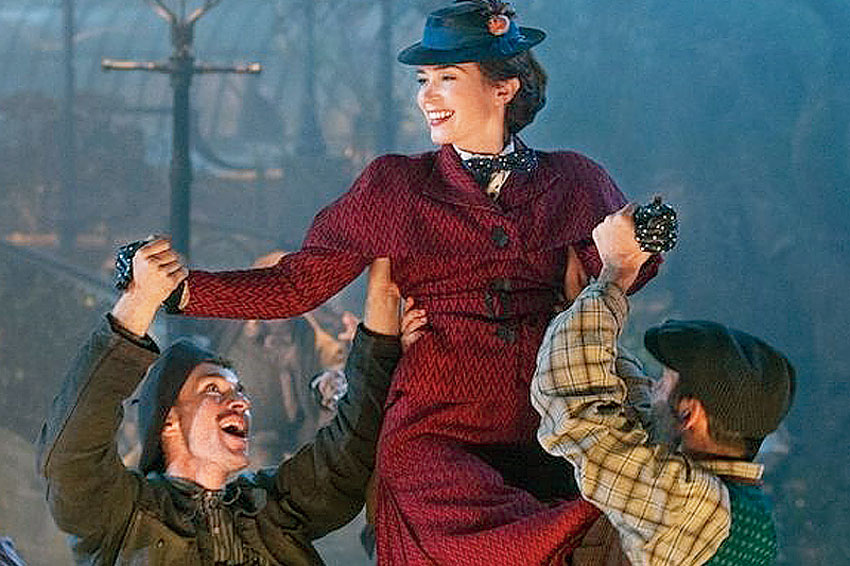During a show-pausing turn in Mary Poppins Returns, Lin-Manuel Miranda takes centre stage to sing and syncopate, and the movie flickers to life. Suddenly, it becomes clear that the people who made this largely charmless venture with its hard-smiling nanny might have created something memorable, even good and hummable if they had turned it over to Miranda. Horizons open up when you consider what might have happened if Disney had let him give Mary Poppins a meaningful do-over similar to his revisionist take on American history in the musical Hamilton.
Bathed in nostalgia, Mary Poppins Returns is being framed as a homage, and there’s clearly some love here. Mostly, it is a modest update, one that has brushed off the story, making it louder, harsher, more aggressively smiley. It picks up several decades after the 1964 film Mary Poppins — starring the sublimely synced Julie Andrews and Dick Van Dyke — concluded. Michael and Jane, the two Banks children at the centre of the original tale, have grown up to become a grieving widower (Ben Whishaw) and an ebullient union organiser (Emily Mortimer). Michael has three children (the peewees Pixie Davies, Nathanael Saleh and Joel Dawson).
The strangest thing about the new movie isn’t that Mary Poppins (Emily Blunt) appears from parts unknown with a talking umbrella and capacious carpetbag. Even if you have never seen the 1964 film or read one of PL Travers’s books, the image of this floating woman — a deus ex machina who mysteriously, magically arrives in the most delightful way — still resonates in the Disney-nurtured cultural imagination. As the stern but loving parental substitute, she embodies the kind of secular saviour Disney excels in. No, what’s odd here is how closely the new movie follows the original’s arc without ever capturing its bliss or tapping into its touching delicacy of feeling.
So, once again, Mary Poppins glides in to save the day and, more specifically, to take care of some gently neglected if unquestionably loved Banks children. Michael adores his sons and daughter, but his wife has recently died, and he’s in mourning. Notably, in the 1964 movie, the mother is a distracted parent but also an attractively vibrant suffragette who opens the film warbling about equality — “We’re fighting for our rights, militantly!” — in the cheeky, rousing Sister Suffragette.
The addition of profound loss fits the Disney dead-mother template, but it invests the movie with a heaviness it can’t persuasively navigate, eventually drowning it in treacle. Set during the Great Depression, also known in Britain as the Great Slump, of the 1930s, the story returns Mary Poppins to the same multistoreyed house at 17 Cherry Tree Lane. Decades earlier, she had to persuade Mr Banks to pay attention to his children; now, she has to pull Michael out of his own catastrophic depression so he can tend to his children and save their home from the bank. (They have a housekeeper, played by Julie Walters; Colin Firth all but twirls his moustache as a banker.)
Written by David Magee and directed by Rob Marshall, the movie ratchets up more than the family’s existential stakes. Almost everything in Mary Poppins Returns looks, feels and sounds like a sales pitch, with the exception of Whishaw’s emotional rawness, which creates jagged little holes in the manufactured uplift. Much seems the same storywise, though, just amped up. Blunt is versatile and a fine singer, but like most of the other actors, she’s giving a broad performance rather than a convincingly felt one.
It’s perhaps unsurprising that the songs by Marc Shaiman and Scott Wittman — who have done memorable work elsewhere — are the gravest disappointment. It may be unfair to compare the new movie’s songs to the originals, which were written by the brothers Richard M. Sherman and Robert B. Sherman, whose words and music for Mary Poppins are among the greatest in the Hollywood songbook. A Spoonful of Sugar, Jolly Holiday, Chim Chim Cher-ee, Let’s Go Fly a Kite’ and of course Supercalifragilisticexpialidocious — these are songs that get in your head, body, memory, and there’s nothing here with comparable melodic or lyrical staying power.
There are some fine moments, as well as consistently eye-stroking costumes from Sandy Powell. There’s also Trip a Little Light Fantastic, a complexly staged number (Marshall is one of the movie’s choreographers) that features Miranda and an army of his fellow lamplighters, known as leeries. This is the contemporary version of the original movie’s rooftop number Step in Time. Now, the leeries are massing together and are more earthbound even while jumping in buoyant synchronicity. Some are also riding on BMX bicycles, anachronisms that give the movie a whiff of contemporary desperation that signals an endeavour reaching for honest nostalgia and trapped by bloodless marketing.










